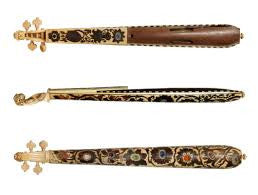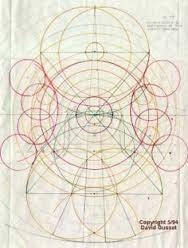
The question of when and where the bow was invented is of interest because the bow made possible several of the most important instruments in music today. Authorities give different answers to this question, and this article will give only the predominant opinion.
Scholars are agreed that stringed instruments as a category existed long before the bow. There was a long period—possibly thousands of years—in which all stringed instruments were plucked.
In fact, it is likely that bowed instruments are not much more than a thousand years old. Eric Halfpenny, writing in the 1988 Encyclopædia Britannica, says "bowing can be traced as far back as the Islamic civilization of the 10th century... it seems likely that the principle of bowing originated among the nomadic horse riding cultures of Central Asia, whence it spread quickly through Islam and the East, so that by 1000 it had almost simultaneously reached China, Java, North Africa, the Near East and Balkans, and Europe." Halfpenny notes that in many Eurasian languages the word for "bridge" etymologically means "horse," and that the Chinese regarded their own bowed instruments (huqin) as having originated with the "barbarians" of Central Asia.
The Central Asian theory is endorsed by Werner Bachmann, writing in The New Grove Dictionary of Music and Musicians. Bachmann notes evidence from a tenth-century Central Asian wall painting for bowed instruments in what is now the city of Kurbanshaid in Tajikistan.
Circumstantial evidence also supports the Central Asian theory. All the elements that were necessary for the invention of the bow were probably present among the Central Asian horse riding peoples at the same time:
- In a society of horse-mounted warriors (the horse peoples included the Huns and the Mongols), horsehair obviously would have been available.
- Central Asian horse warriors specialized in the military bow, which could easily have served theinventor as a temporary way to hold horsehair at high tension.

- From all this it is tempting to imagine the invention of the bow: some Mongol warrior, having just used rosin on his equipment, idly stroked his harp or lyrewith a rosin-dusted finger and produced a brief continuous sound, which caused him to have an inspiration; whereupon he seized his bow, restrung it with horsehair, and so on. Obviously, the degree to which this fantasy is true will never be known. To this day, horsehair for bows is taken from places with harsh cold climates, including Mongolia,[7] as such hair offers a better grip on the strings.
-
Rosin, crucial for creating sound even with coarse horsehair, is used by traditional archers to maintain the integrity of the string and (mixed withbeeswax) to protect the finish of the bow.[8]
However the bow was invented, it soon spread very widely. The Central Asian horse peoples occupied a territory that included the Silk Road, along which goods and innovations were transported rapidly for thousands of miles (including, via India, by sea to Java). This would account for the near-simultaneous appearance of the musical bow in the many locations cited by Halfpenny.
 The last of the bowed yoke lyres with fingerboard was the "modern" (ca. 1485 – ca. 1800) Welsh crwth. It had several predecessors both in the British Isles and in Continental Europe. Pitch was changed on individual strings by pressing the string firmly against the fingerboard with the fingertips. Like a violin, this method shortened the vibrating length of the string to produce higher tones, while releasing the finger gave the string a greater vibrating length, thereby producing a tone lower in pitch. This is the principle on which the modern violin and guitar work.Lyres appearing to have emerged independently of Greco-Roman prototypes were used by the Teutonic, Gallic,Scandinavian, and Celtic peoples over a thousand years ago. Dates of origin, which probably vary from region to region, cannot be determined, but the oldest known fragments of such instruments are thought to date from around the sixth century of the Common Era. After the bow made its way into Europe from the Middle-East, around two centuries later, it was applied to several species of those lyres that were small enough to make bowing practical. There came to be two broad classes of bowed European yoke lyres: those with fingerboards dividing the open space within the yoke longitudinally, and those without fingerboards. The last surviving examples of instruments within the latter class were the Scandinaviantalharpa and the Finnish jouhikko. Different tones could be obtained from a single bowed string by pressing the fingernails of the player's left hand against various points along the string to fret the string.
The last of the bowed yoke lyres with fingerboard was the "modern" (ca. 1485 – ca. 1800) Welsh crwth. It had several predecessors both in the British Isles and in Continental Europe. Pitch was changed on individual strings by pressing the string firmly against the fingerboard with the fingertips. Like a violin, this method shortened the vibrating length of the string to produce higher tones, while releasing the finger gave the string a greater vibrating length, thereby producing a tone lower in pitch. This is the principle on which the modern violin and guitar work.Lyres appearing to have emerged independently of Greco-Roman prototypes were used by the Teutonic, Gallic,Scandinavian, and Celtic peoples over a thousand years ago. Dates of origin, which probably vary from region to region, cannot be determined, but the oldest known fragments of such instruments are thought to date from around the sixth century of the Common Era. After the bow made its way into Europe from the Middle-East, around two centuries later, it was applied to several species of those lyres that were small enough to make bowing practical. There came to be two broad classes of bowed European yoke lyres: those with fingerboards dividing the open space within the yoke longitudinally, and those without fingerboards. The last surviving examples of instruments within the latter class were the Scandinaviantalharpa and the Finnish jouhikko. Different tones could be obtained from a single bowed string by pressing the fingernails of the player's left hand against various points along the string to fret the string.
While the dates of origin and other evolutionary details of the European bowed yoke lyres continue to be disputed among organologists, there is general agreement that none of them were the ancestors of modern orchestral bowed stringed instruments, as once was thought.
Paraphrased from Wikipaedia
Continue reading























 The last of the bowed yoke lyres with fingerboard was the "modern" (
The last of the bowed yoke lyres with fingerboard was the "modern" (